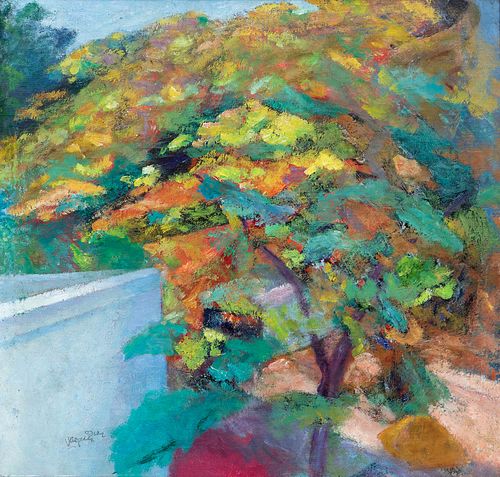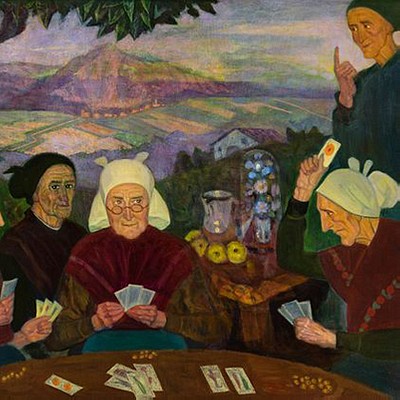DANIEL VÁZQUEZ DÍAZ (Nerva, Huelva, 1882 - Madrid, 1969). "Corner of my house". Oil on canvas.
Lot 107
About Seller
Setdart Auction House
Carrer Aragó 346
Barcelona
Spain
Setdart Subastas was born in 2004 and is currently the first online art auction in Spain with solidity, prestige and reliability guaranteed by our more than 60,000 users. Setdart has a young, dynamic and enterprising team ready to successfully manage the purchase and sale of art works through custom...Read more
Estimate:
EUR€8,000 - EUR€9,000
$8,602.15 - $9,677.42
Absentee vs Live bid
Two ways to bid:
- Leave a max absentee bid and the platform will bid on your behalf up to your maximum bid during the live auction.
- Bid live during the auction and your bids will be submitted real-time to the auctioneer.
Bid Increments
| Price | Bid Increment |
|---|---|
| EUR€0 | EUR€10 |
| EUR€200 | EUR€25 |
| EUR€500 | EUR€50 |
| EUR€1,000 | EUR€100 |
| EUR€3,000 | EUR€200 |
| EUR€5,000 | EUR€500 |
| EUR€10,000 | EUR€1,000 |
| EUR€20,000 | EUR€2,000 |
| EUR€50,000 | EUR€5,000 |
About Auction
By Setdart Auction House
Dec 14, 2021
Set Reminder
2021-12-14 08:00:00
2021-12-14 08:00:00
America/New_York
Bidsquare
Bidsquare : 19th & 20th Century Fine Art
https://www.bidsquare.com/auctions/setdart-auction-house/19th-20th-century-fine-art-7992
Gaudi, Sorolla, Torres Garcia, Maclet, TSUGUHARU FOUJITA, Benjamin Palencia Setdart Auction House sofia@setdart.com
Gaudi, Sorolla, Torres Garcia, Maclet, TSUGUHARU FOUJITA, Benjamin Palencia Setdart Auction House sofia@setdart.com
- Lot Description
DANIEL VÁZQUEZ DÍAZ (Nerva, Huelva, 1882 - Madrid, 1969). "Corner of my house". Oil on canvas. Signed in the lower left corner. Measurements: 51 x 53 cm; 69 x 71 cm (frame). In this work Daniel Vázquez Díaz demonstrates his absolute mastery of the technique and the capture of the landscape, in an image of his house in which he manages to synthesize the naturalistic expression, the personal expression and the pictorial order. We see a sensitive brushstroke, which explores the space and gives it form and entity, creating volumes, lights and shadows, defining an atmosphere captured with great sensitivity. Through a purely personal language, Vázquez Díaz synthesizes the basic elements of representation and expressiveness of painting, as can be seen in the intensity of his colors or in the rigor of his compositional structure. Daniel Vázquez Díaz began painting in his student years, after discovering the work of Zurbarán and El Greco. In 1903 he moved to Madrid to focus on painting and copying the masters of the Prado, and there he became friends with Juan Gris, Solana and Dario de Regoyos. Three years later he settled in Paris, where he worked with the sculptor Antoine Bourdelle and met Picasso, Braque, Modigliani and Max Jacob, among others, and assimilated a certain avant-garde spirit. During these years he began to develop his personal style, which mixed the constructive brushstrokes of Cézanne with the geometric structure and planes of cubism. Upon his return to Spain in 1918, he began teaching, first in his studio and later at the San Fernando School of Fine Arts, where he obtained the chair of mural painting in 1932. Through his classes, Vázquez Díaz will spread a cubism of architectural monumentality, and that serves as a bridge to the young artists with the trends that were developing in the rest of Europe. In addition to being an excellent landscape painter, Vázquez Díaz stood out as an illustrator and portraitist of some of the most important figures of his time. Among his mural works, it is worth mentioning those made for the monastery of La Rábida in Huelva, between 1927 and 1930, which consecrated him as a painter. In 1968, a year before his death, he was appointed member of the Academy of San Fernando. He is currently represented in the Reina Sofía National Museum, the museum that bears his name in Nerva, the Patio Herreriano in Valladolid, the Telefónica Foundation and the Fine Arts Museums of Bilbao and Seville, among others.
- Shipping Info
-
In-house shipping available. Please inquire at admin@setdart.com.
-
- Buyer's Premium



 EUR
EUR CAD
CAD AUD
AUD GBP
GBP MXN
MXN HKD
HKD CNY
CNY MYR
MYR SEK
SEK SGD
SGD CHF
CHF THB
THB
















